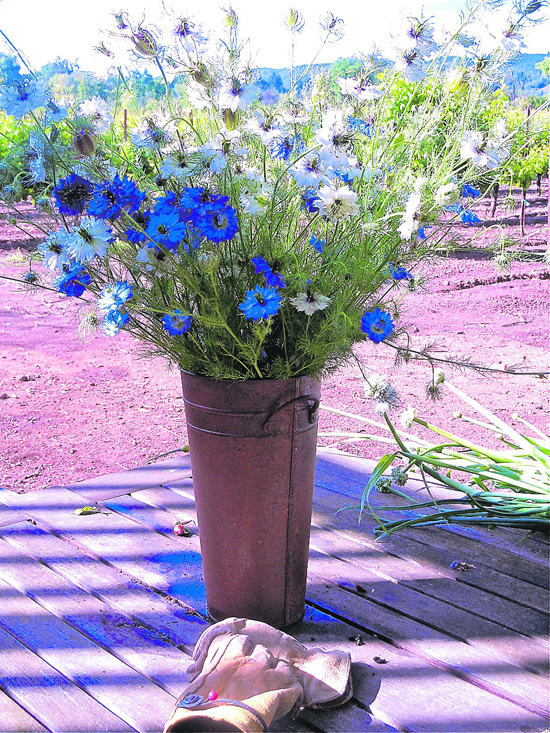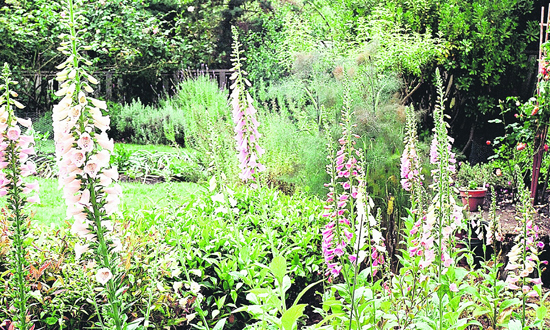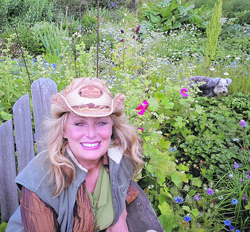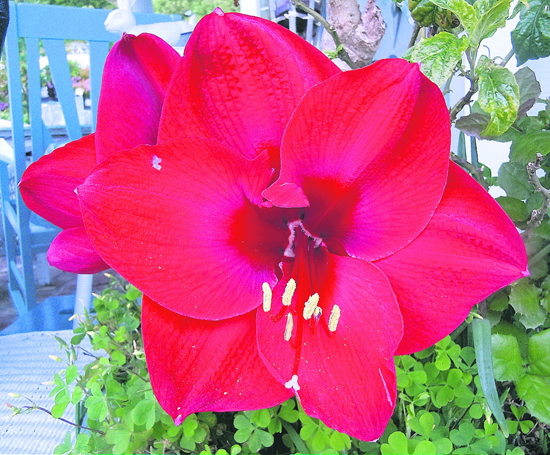 | | | A summer centerpiece with blue and white Nigelia in a copper
bucket. Leeks and onions have been picked for roasting.
| | | | | | Whether the result is a horticultural masterpiece or only a modest vegetable patch, the hope for a glorious future is at the heart of all gardening.' Marina Shinz, photographer
 Every morning after making my early bird rounds of my property with a cup of java, I go to the office, sit down to the computer, respond to emails, and post a quip to Facebook, Twitter, and Linked-in. Usually my musings regard the literacy charity, Be the Star You Are!(r) or an insight about the rewards of working with and coaching teens. A few responses from fans are posed to my profile, applauding the purpose or asking for further information, yet nothing remarkable. However, on the days that my blurbs pertain to garden issues, my inbox overflows with comments. Friend requests arrive from total strangers across the globe insisting that we are colleagues because we are gardeners.
Every morning after making my early bird rounds of my property with a cup of java, I go to the office, sit down to the computer, respond to emails, and post a quip to Facebook, Twitter, and Linked-in. Usually my musings regard the literacy charity, Be the Star You Are!(r) or an insight about the rewards of working with and coaching teens. A few responses from fans are posed to my profile, applauding the purpose or asking for further information, yet nothing remarkable. However, on the days that my blurbs pertain to garden issues, my inbox overflows with comments. Friend requests arrive from total strangers across the globe insisting that we are colleagues because we are gardeners.
 The love of gardening is our equalizer and common denominator. Our gardens become our personal playground, a sandbox of building, planting, exercising, sharing, and growing. According to the journal, Environmental Science and Technology, it only takes five minutes in the garden every day to improve both your mood and your self-esteem. Researchers suggest that gardening is in our evolutionary genetics. When we tend a patch of earth, no matter how small, we feel more peaceful, generous, and optimistic. Prevention Magazine shared data indicating that biochemical pathways in our brains are stimulated and satisfied by our primal longings to commune with nature.
The love of gardening is our equalizer and common denominator. Our gardens become our personal playground, a sandbox of building, planting, exercising, sharing, and growing. According to the journal, Environmental Science and Technology, it only takes five minutes in the garden every day to improve both your mood and your self-esteem. Researchers suggest that gardening is in our evolutionary genetics. When we tend a patch of earth, no matter how small, we feel more peaceful, generous, and optimistic. Prevention Magazine shared data indicating that biochemical pathways in our brains are stimulated and satisfied by our primal longings to commune with nature.
 Gardening is good for our bank balances, too. The associated Landscape Contractors of America calculate that landscaping adds as much as 14% to the resale value of a building and helps it sell six weeks earlier. Planting ecologically benefits our planet by reducing soil erosion and filtering pollutants.
Gardening is good for our bank balances, too. The associated Landscape Contractors of America calculate that landscaping adds as much as 14% to the resale value of a building and helps it sell six weeks earlier. Planting ecologically benefits our planet by reducing soil erosion and filtering pollutants.
 Statistics abound with the how and why people garden resulting in fascinating findings. With an accuracy rate of 95 % (plus or minus 4.2 percentage points) representing the attitudes of over one hundred million households, the spring Technometrica Market Intelligence survey found that nearly one half of the population will be gardening in their backyards with a little more than a quarter sprucing up their front spaces this summer.
Statistics abound with the how and why people garden resulting in fascinating findings. With an accuracy rate of 95 % (plus or minus 4.2 percentage points) representing the attitudes of over one hundred million households, the spring Technometrica Market Intelligence survey found that nearly one half of the population will be gardening in their backyards with a little more than a quarter sprucing up their front spaces this summer.
 Despite the economic challenges, 51% percent of consumers favor buying plants of the highest quality, regardless of price. Only 27% chose purchases that were the least expensive.
Despite the economic challenges, 51% percent of consumers favor buying plants of the highest quality, regardless of price. Only 27% chose purchases that were the least expensive.
 Where are gardeners getting their ideas for styles, trends, and tips? A whopping 34% indicated that they read books, magazines, and newspaper gardening articles before planning and planting. I hope they are perusing Digging Deep!
Where are gardeners getting their ideas for styles, trends, and tips? A whopping 34% indicated that they read books, magazines, and newspaper gardening articles before planning and planting. I hope they are perusing Digging Deep!
 With people more aware of the health benefits of local produce, vegetable gardening is more popular than ever. Two thirds of those surveyed grow their own food and 82% are motivated to do so because homegrown vegetables, fruits, and herbs are tastier, pack more nutrients, and are freshest from the terra to table. Although most Lamorinda gardens are larger, it was interesting to note that the majority of avid gardeners worked a plot of land smaller than ten feet by ten feet!
With people more aware of the health benefits of local produce, vegetable gardening is more popular than ever. Two thirds of those surveyed grow their own food and 82% are motivated to do so because homegrown vegetables, fruits, and herbs are tastier, pack more nutrients, and are freshest from the terra to table. Although most Lamorinda gardens are larger, it was interesting to note that the majority of avid gardeners worked a plot of land smaller than ten feet by ten feet!
 Gardening is the number one hobby of Americans. Aside from beautifying our surroundings and providing edible nourishment, the physical, mental, spiritual, and emotional benefits shine for gardeners of all ages. Gardening increases strength, flexibility, and body tone. Forty-five minutes of active gardening burns the same number of calories as thirty minutes of aerobics. Gardening is "real" exercise. One hour of weeding burns 300 calories, the same as walking or bicycling at a moderate pace.
Gardening is the number one hobby of Americans. Aside from beautifying our surroundings and providing edible nourishment, the physical, mental, spiritual, and emotional benefits shine for gardeners of all ages. Gardening increases strength, flexibility, and body tone. Forty-five minutes of active gardening burns the same number of calories as thirty minutes of aerobics. Gardening is "real" exercise. One hour of weeding burns 300 calories, the same as walking or bicycling at a moderate pace.
 Gardening is a stress buster, especially when you are hacking away at those menacing weeds instead of seething with business burnout. By digging in the dirt, we connect with nature, allowing us to unplug from our technological turntable. Patience is learned, as we can't rush a beet. With the long cold and rainy season experienced this year, many of the seeds I planted in May are only now sprouting. Mother Nature decides when germination occurs. We are the worker bees.
Gardening is a stress buster, especially when you are hacking away at those menacing weeds instead of seething with business burnout. By digging in the dirt, we connect with nature, allowing us to unplug from our technological turntable. Patience is learned, as we can't rush a beet. With the long cold and rainy season experienced this year, many of the seeds I planted in May are only now sprouting. Mother Nature decides when germination occurs. We are the worker bees.
 The garden is the foundation for creativity as we combine colors, textures, form, and function. No matter what style, shape, or size, our gardens are the play structures for our imaginations, a gathering place where family and friends find tranquility, enjoyment, and camaraderie.
The garden is the foundation for creativity as we combine colors, textures, form, and function. No matter what style, shape, or size, our gardens are the play structures for our imaginations, a gathering place where family and friends find tranquility, enjoyment, and camaraderie.
 Gardening is our hope for the future. This summer, dig in, plant a playground, and welcome the flower power paybacks.
Gardening is our hope for the future. This summer, dig in, plant a playground, and welcome the flower power paybacks.
 Ask Cynthia Brian, Your Gardening Guide on the Side
Ask Cynthia Brian, Your Gardening Guide on the Side
 Steep thyself in a bowl of summer. --Virgil
Steep thyself in a bowl of summer. --Virgil
 Throughout the year, Lamorinda Weekly readers email me with horticultural queries. Many gardeners share the same concerns. These are the three most popular inquiries this year.
Throughout the year, Lamorinda Weekly readers email me with horticultural queries. Many gardeners share the same concerns. These are the three most popular inquiries this year.
 Question: How can I bring butterflies to my garden?
Question: How can I bring butterflies to my garden?
 Answer: Our beautiful winged friends are drawn to bright, cheerful flowers. When you plant a garden filled with their favorite feasts, you have planned their party. Echinacea, zinnia, butterfly bush, penstemon, lantana, Mexican sunflowers, and cosmos are a few of the floral favors. Lilac bushes and wildflowers are also attractive. Encourage them to stay longer and multiply, by growing host plants such as milkweed, fennel, parsley, and dill for their offspring to dine al fresco. The eggs hatch into caterpillars, hungrily nibbling on the treats until metamorphose magic. Keep a small saucer of muddy water for them to sip a cool drink. If you planted a potager, your herbs, flowers, and vegetables will be mingled together offering the best retreat for these colorful insects.
Answer: Our beautiful winged friends are drawn to bright, cheerful flowers. When you plant a garden filled with their favorite feasts, you have planned their party. Echinacea, zinnia, butterfly bush, penstemon, lantana, Mexican sunflowers, and cosmos are a few of the floral favors. Lilac bushes and wildflowers are also attractive. Encourage them to stay longer and multiply, by growing host plants such as milkweed, fennel, parsley, and dill for their offspring to dine al fresco. The eggs hatch into caterpillars, hungrily nibbling on the treats until metamorphose magic. Keep a small saucer of muddy water for them to sip a cool drink. If you planted a potager, your herbs, flowers, and vegetables will be mingled together offering the best retreat for these colorful insects.
 Question: Last year I had gorgeous daffodil blooms. This year, not a single daffodil flowered, but there were loads of beautiful leaves. What happened?
Question: Last year I had gorgeous daffodil blooms. This year, not a single daffodil flowered, but there were loads of beautiful leaves. What happened?
 Answer: This is the most frequent complaint I get in the spring from gardeners who love a perfect yard. My guess is that last spring after your daffodil blooms faded you either cut, braided, or tied the leaves before they had a chance to completely die back. As unsightly as they are, it is imperative to allow the yellowing leaves to naturally disintegrate for the photosynthesis to feed the bulb for the following season. When the leaves are golden brown and crackly like a potato chip, then, and only then is it time to clean up the plant. If you find it unsightly to leave the fading leaves in your beds, plant annuals or a ground cover around the daffodils. By doing this, you will ensure double the amount of blooms next season. By the way, this procedure is necessary for all blooming spring bulbs, not just daffodils. In my garden, I clean up the browned leaves during the month of June, adding them to the compost bin.
Answer: This is the most frequent complaint I get in the spring from gardeners who love a perfect yard. My guess is that last spring after your daffodil blooms faded you either cut, braided, or tied the leaves before they had a chance to completely die back. As unsightly as they are, it is imperative to allow the yellowing leaves to naturally disintegrate for the photosynthesis to feed the bulb for the following season. When the leaves are golden brown and crackly like a potato chip, then, and only then is it time to clean up the plant. If you find it unsightly to leave the fading leaves in your beds, plant annuals or a ground cover around the daffodils. By doing this, you will ensure double the amount of blooms next season. By the way, this procedure is necessary for all blooming spring bulbs, not just daffodils. In my garden, I clean up the browned leaves during the month of June, adding them to the compost bin.
 Question: I have a pond with a recirculating pump, yet, there are mosquito larvae swimming around. What do I do?
Question: I have a pond with a recirculating pump, yet, there are mosquito larvae swimming around. What do I do?
 Answer: Now that the sunny weather has finally arrived and summer is around the corner, we have to be proactive with keeping the mosquitoes at bay. Some mosquitoes carry the West Nile virus dangerous to humans, while others endanger the lives of our canine friends by infecting them with heartworm disease. Be vigilant in emptying any standing water as even a couple of tablespoons in a container entices mosquitoes. When the weather heats up, it takes three to five days for the larvae to mature into breeding, biting brats.
Answer: Now that the sunny weather has finally arrived and summer is around the corner, we have to be proactive with keeping the mosquitoes at bay. Some mosquitoes carry the West Nile virus dangerous to humans, while others endanger the lives of our canine friends by infecting them with heartworm disease. Be vigilant in emptying any standing water as even a couple of tablespoons in a container entices mosquitoes. When the weather heats up, it takes three to five days for the larvae to mature into breeding, biting brats.
 Probably your pump isn't powerful enough. It may be stirring the water surrounding the immediate area of where it is installed leaving still or stagnant areas at the other end of the pond. My suggestion is to add mosquito fish which, when mature at one inch of length, will devour up to five hundred mosquito larvae per day. Depending on the size of your pond, goldfish or koi are vorcious eaters, although you may want to install netting over the pond to deter the fishing raccoons. You can also buy Mosquito Dunks at your local garden center or hardware store. These two-inch floaters contain Bacilllus thuringiensis v. israelensis, slowly releasing the BT on the water surface. It gradually sinks to the bottom where the larvae feed on it and die. The Mosquito Dunks are not harmful to wildlife, fish, or humans. They last three to four weeks with one dunk covering twenty five to hundred surface feet. You can cut them into quarters for smaller areas. If you feel you have a mosquito problem, abatement is offered for free by the Contra Costa County Vector Control Department. Call 925-685-9301 and ask for an inspector to come to your property. They will spray and also give you mosquito fish. In the early 1900's, parts of Contra Costa County were uninhabitable because of mosquitoes and the diseases they brought including malaria and encephalitis. Mosquito abatement began in 1927 and our health has been a priority ever since.
Probably your pump isn't powerful enough. It may be stirring the water surrounding the immediate area of where it is installed leaving still or stagnant areas at the other end of the pond. My suggestion is to add mosquito fish which, when mature at one inch of length, will devour up to five hundred mosquito larvae per day. Depending on the size of your pond, goldfish or koi are vorcious eaters, although you may want to install netting over the pond to deter the fishing raccoons. You can also buy Mosquito Dunks at your local garden center or hardware store. These two-inch floaters contain Bacilllus thuringiensis v. israelensis, slowly releasing the BT on the water surface. It gradually sinks to the bottom where the larvae feed on it and die. The Mosquito Dunks are not harmful to wildlife, fish, or humans. They last three to four weeks with one dunk covering twenty five to hundred surface feet. You can cut them into quarters for smaller areas. If you feel you have a mosquito problem, abatement is offered for free by the Contra Costa County Vector Control Department. Call 925-685-9301 and ask for an inspector to come to your property. They will spray and also give you mosquito fish. In the early 1900's, parts of Contra Costa County were uninhabitable because of mosquitoes and the diseases they brought including malaria and encephalitis. Mosquito abatement began in 1927 and our health has been a priority ever since.

 Question: What is your favorite specimen in your garden?
Question: What is your favorite specimen in your garden?
 Answer: This is an unfair question! It's like asking me which of my children I love most. Since you've been reading Digging Deep-Gardening with Cynthia, you already know that I am a zealous, hands-in-the-muck, extreme DIY gardener. I get excited literally every day when something new bursts into bloom. This year, in the vegetable department, I am head over heels with my two artichoke plants growing in my potager. They have provided bushels of sweet, almost thistle free scrumptiousness for weeks with no end in sight. The most unusual delight is the triple blooms of my scarlet red amaryllis. Normally entertaining me at Christmas, it surprised me with a dazzling dinner plate size display this week. Finally, my roses have never been more glorious. My home is filled with their brilliance and fragrance. (FYI- July Digging Deep will be a tribute to these precious plants.) Because of the rains, my orchard is disappointing. I have no cherries, apricots, or Santa Rosa plums this year. There will be a small crop of Asian pears, apples, peaches, loquats, mulberries, currants, grape
Answer: This is an unfair question! It's like asking me which of my children I love most. Since you've been reading Digging Deep-Gardening with Cynthia, you already know that I am a zealous, hands-in-the-muck, extreme DIY gardener. I get excited literally every day when something new bursts into bloom. This year, in the vegetable department, I am head over heels with my two artichoke plants growing in my potager. They have provided bushels of sweet, almost thistle free scrumptiousness for weeks with no end in sight. The most unusual delight is the triple blooms of my scarlet red amaryllis. Normally entertaining me at Christmas, it surprised me with a dazzling dinner plate size display this week. Finally, my roses have never been more glorious. My home is filled with their brilliance and fragrance. (FYI- July Digging Deep will be a tribute to these precious plants.) Because of the rains, my orchard is disappointing. I have no cherries, apricots, or Santa Rosa plums this year. There will be a small crop of Asian pears, apples, peaches, loquats, mulberries, currants, grape |




